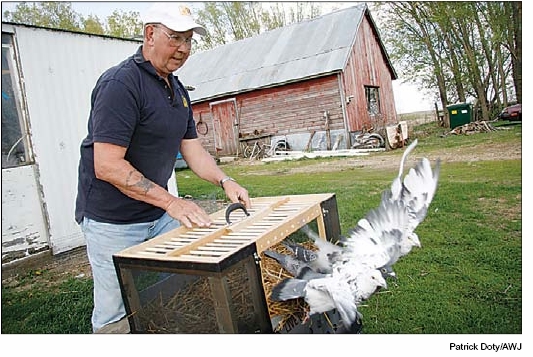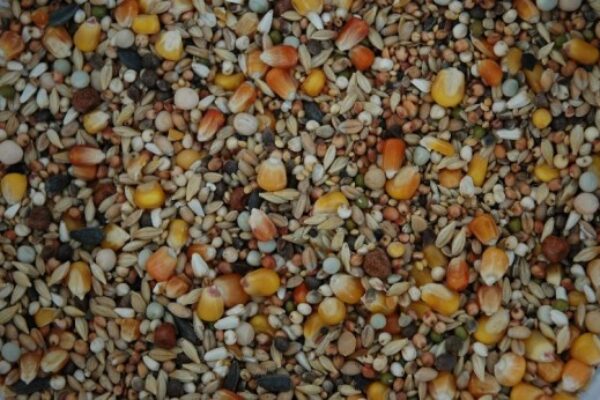
When we start road training, we start about 1/2 mile away from the loft, releasing the birds at this point 2-3 times. Remember, the routine is the same training, land, trap and peanuts.
We gradually increase the distance of our training tosses to 1, 5, 10, 20 miles. We stay at each location 3 times. On the third time at each location we are going to single toss each bird! This is the most important part of the young bird’s education. These single tosses force the bird to think on its own and not to rely on other birds to follow home. This is the first step in teaching the bird to be independent, and to build confidence in its own ability to navigate. Release each bird separately, about 10 minutes apart, and it must rely on its own homing skills. These single tosses are only made after a bird has been to the location at least 2 times with the group.
We agree that our birds must possess early physical maturity, and also, more importantly, mental ability to race and home successfully at a young age. The best way to teach this is to single toss the birds. When we train at short locations like 5, 10, 20 miles, these training tosses can be 2-3 times a day. It is better to have 2 ten mile tosses than 1 twenty mile toss for the birds to gain experience. Remember, feed and water is always available to the birds, and the routine is the same – train, land, trap, peanuts. If they know that the peanuts are waiting for them, you will have no problem with trapping.
When we look for locations to release your birds, always try to find large land marks that the birds can remember and see at great distances. After we reach the 40 mile toss location or the water, whichever comes first, all training tosses are single bird tosses. The birds must learn to fly independently from this point.
Our training tosses are now made as close to the water as possible: Varied NORTH and SOUTH OF OUR STRAIGHT LINE OF FLIGHT. We look for land markers as release points that the birds can use as they come off the water.
IMPORTANT: The birds are always sent to training tosses with a full tank of gas, fully fed and watered at all times. Hunger is the most destructive factor for our race birds. If a bird becomes hungry during a training toss or race, the bird develops memory loss, fatigue and loss of weight, all of which can be serious problems. Homing now becomes secondary to the need to survive, many times causing the loss of the bird.
If the birds fly south to north east, then they will probably head toward land first (east), then fly north. We should now single toss our birds south of the straight line of flight at tall land markers that they can recognize as they come off the water. These single tosses must be at least 10 minutes apart. If we release the birds too close together, they will not leave the area, but wait for the other birds and fly home together.
Single tossing creates and teaches mental maturity and intelligence. Many times the trainer overlooks this point. Outwardly many pigeons look good (physically), but it is what is inside that counts on race day (intelligence, confidence and independent thinking to lead, not follow the other birds.) It is important to recognize that a racing pigeon must and does navigate and think for itself independently, and not become a follower. Single tossing helps to educate the bird, and build its confidence to fly alone.
Another important area that is many times overlooked. is that the birds will eat and drink in the shipping crates that the local club uses. Successful trainers educate their young birds by obtaining a crate identical to the one used by the club. This crate is the same size, color, same location of feed and water, same release location and has the same opening as the club’s crate. They now school and educate the birds to eat and drink in these crates many times before the first race. They prepare the birds for what to expect on shipping night. This is a big advantage for the young birds to know where to look for food and water. We take no chances that the birds will find it on their own. We have prepared them in advance for this new experience.
In each situation, we have prepared our birds for new experiences in advance, all of our teaching and learning techniques help our birds to think and navigate for themselves independently from all the other birds in the race.
We must understand that we breed and train athletes. There is no difference between training and coaching a human or an animal athlete. They both need the athletic ability, proper training and coaching before the competition, excellent diets, good health and hygiene habits, plenty of rest, regular routine and a stress free environment to stay in condition and compete week after week to win the large prizes.
In the USA we have several types of races for both young birds and old birds. We place a great value on birds that compete successfully in a 1 bird derby or futurity race. Each loft enters its best bird (1 only) for this special race. The best against the best of each loft. The distances of the races range from 300-500 miles. These birds are special because they have intelligence, orientation, navigating ability, motivation, determination, desire, courage and heart. They fly as individuals or alone for distances of 300-500 miles with only their own ability. They are leaders not followers. The birds that fly these races successfully usually become excellent breeders and become very valuable in their owners’ breeding lofts. In each case the birds must prove themselves under difficult race conditions, after we provide them with the proper education.
Education: Important to Young Bird Training (Part 2 of 2) by Bob Prisco









Feeding yb before a toss is not something I think is good to do!, if you feed them at 5 pm and put them in the training basket by the morning time they should of had a enough to fly straight home for the morning feeding and some Peanuts yb Usually do what they want to they figure out what’s going on from me to you good luck
i think all of you are correct .. but for me i will follow who fits my expectation .. all of your pm are very interesting to me .. i will follow all of this one at a time in my yb and ob .. thanks to all of you .. know i think im ready to train my bird .. thanks again to all ..
hi to all
Hi To all Friends, Posted from 2010 /// 2013 one thing i could not understand the gap of 3 years only 8 racing pigeon fanciers post a comment on young bird training. For me it is where racing starts right from the begin rule them with a hard hand but with love from squicker must show intelligence home ability healthy if that is not presence dont waste your time ,Trev Madigan 25 -03- 2012 hit the nail
Yeh I never feed my birds whiling training them. also when i race them they don’t get much food only enough to last them the night so there hungry by morning. and plus when your birds are hungry the only place they know where to get food /water is there home. unless you fly wild birds lol.
Hi Chris i never feed my birds before a training toss i want them home as quickly as possible
i tried feeding them once before training and they took there time coming home and you don’t
need to feed them much either barley is what i fed them and then they wouldn’t go in and where
i live i can’t have my youngsters all over the place it would be ok i guess in the country but
i don’t see what you are teaching them Brad.
HI chris.
Please post about Resportary.What is it when a bird is barking like a dog?.
He has secondary respiratory problems
HI CHRIS.
I DO LIKE BUTCH,s Artical. Great info.You do not have to spend a Million dollars on pigeons.You are the trainer ,IF you do not dedicate 365 days to the sport ,ore sit on the couch and expect it to happen. Then give the sport away.Good on YA Butch.
TREV Australia.